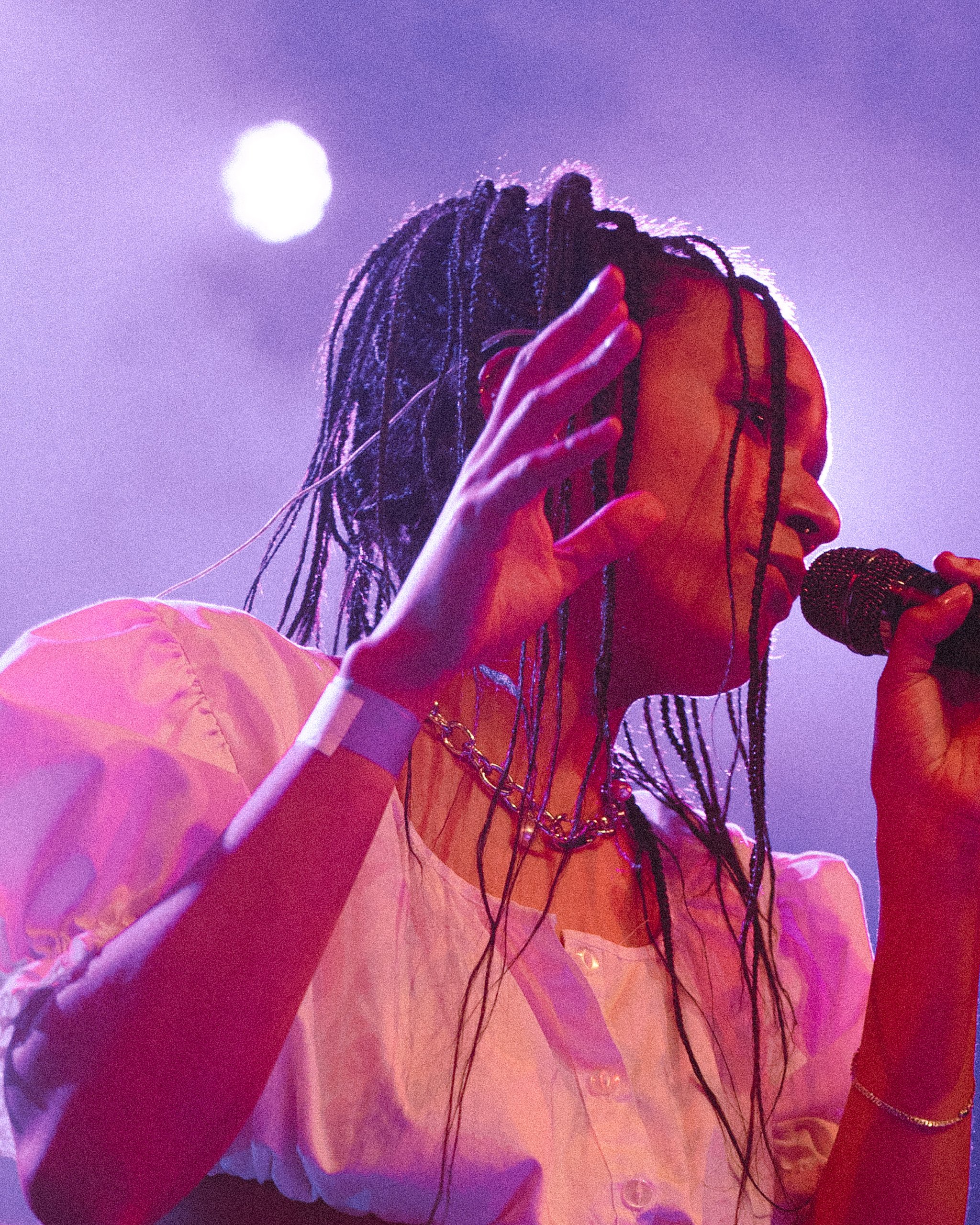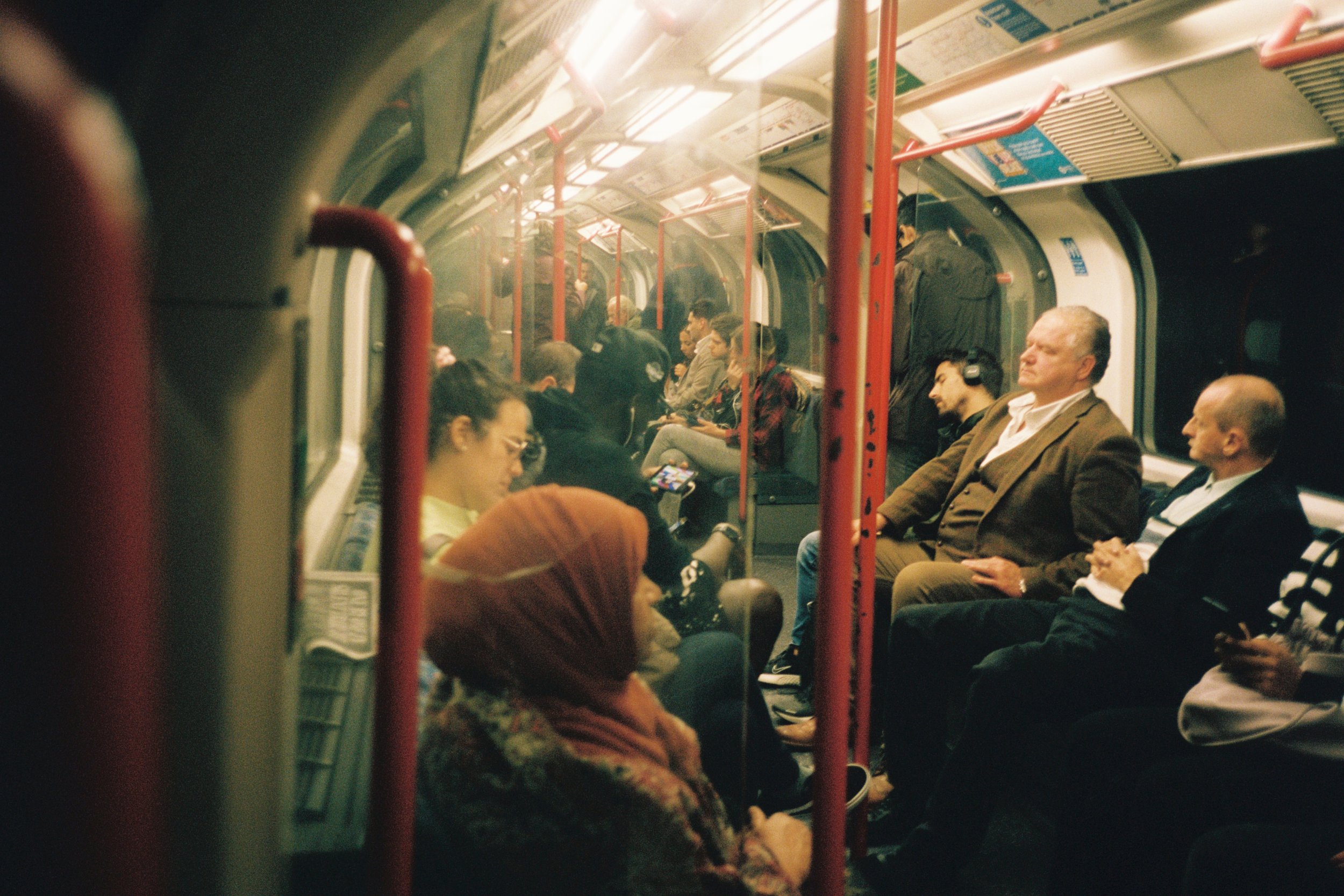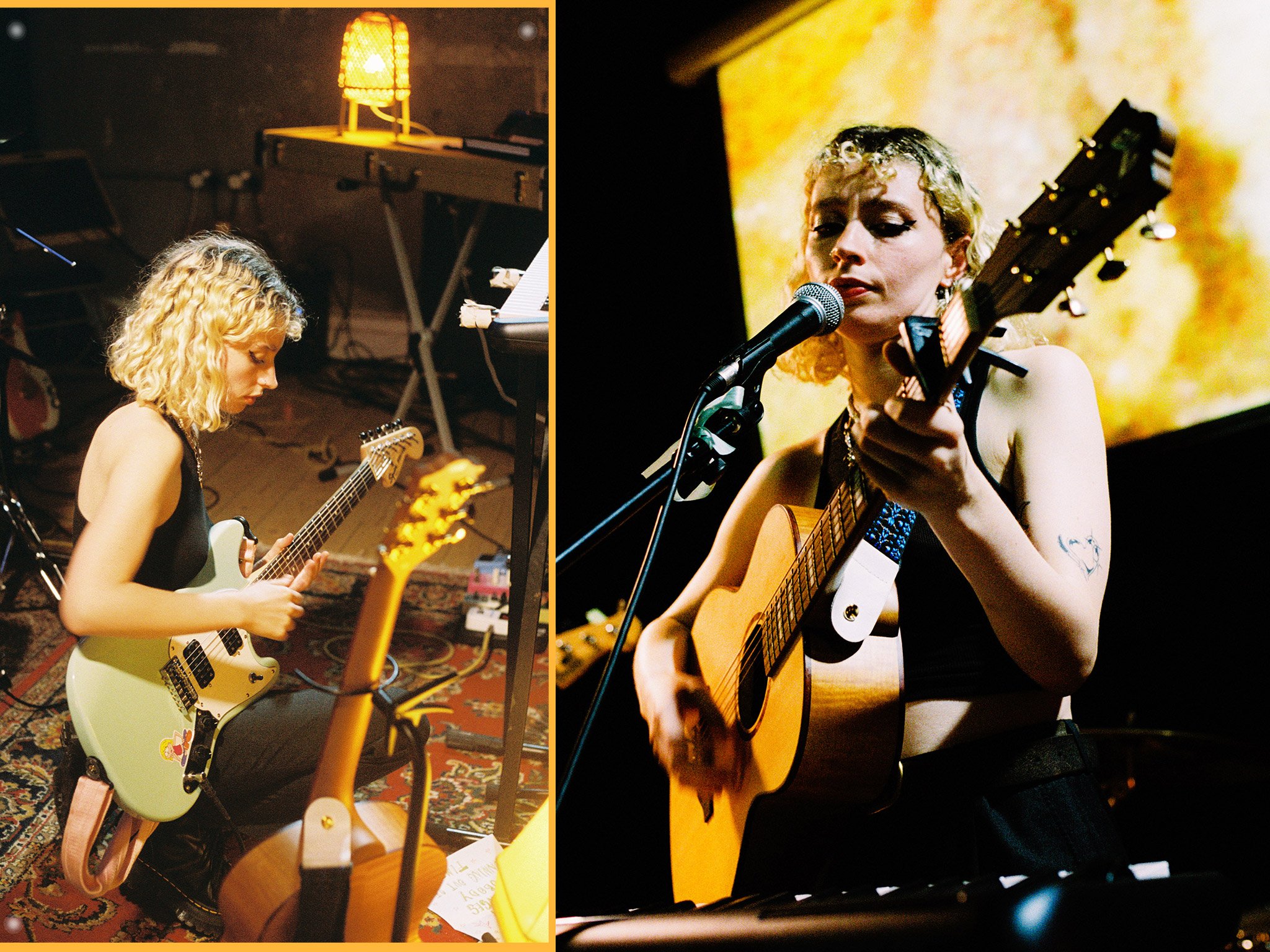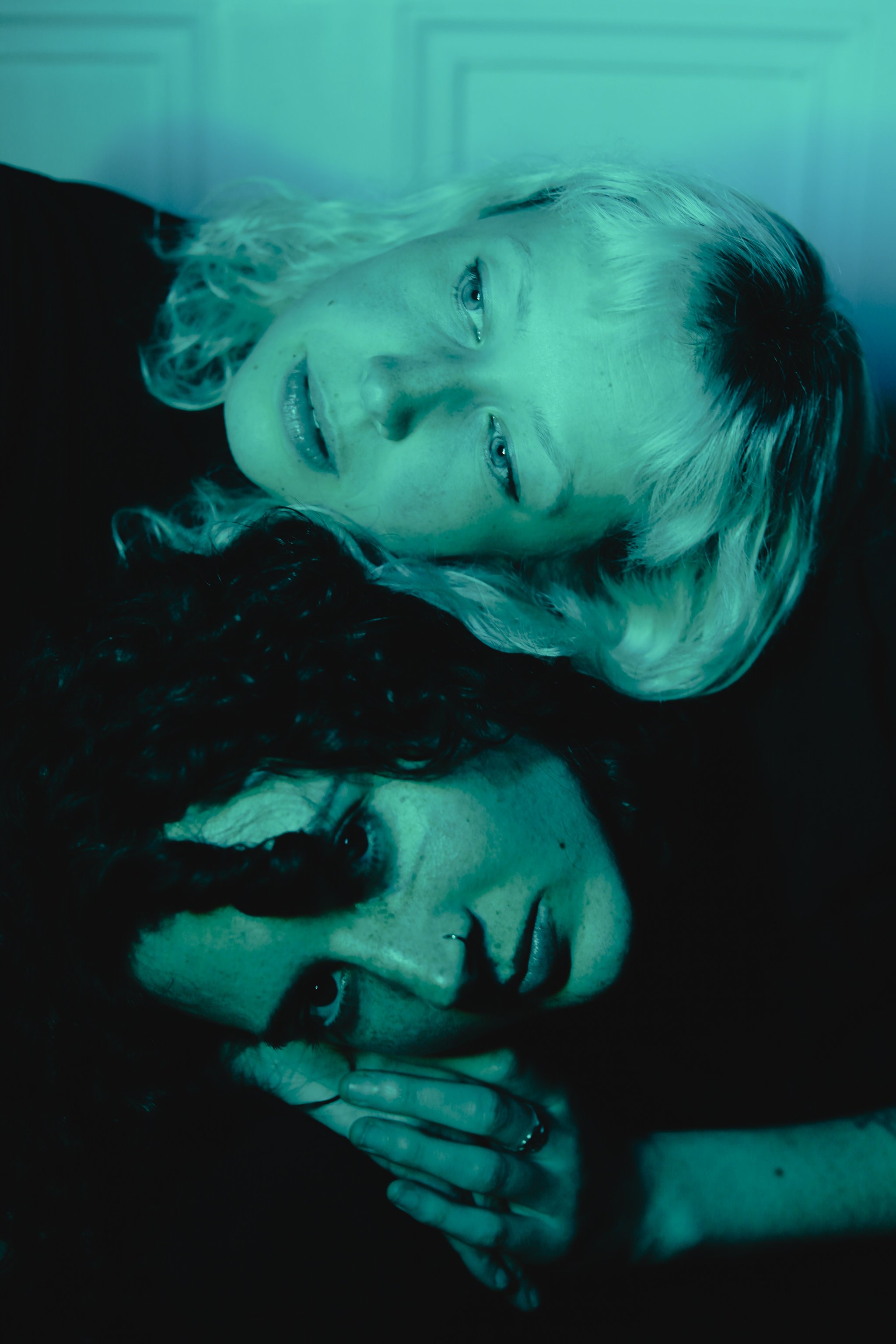From Small-Town China to Photographing Raye for British Vogue: An Interview with Jean Yuzheng
By Lara Delmage
If you’ve been at a gig recently, you might’ve spotted Jean and her camera at the front, dancing along, snapping away. If you weren’t there, you might be one of the many people who’ve seen her images on her Instagram feed (@jeanyuzhengart) or in British Vogue.
The images she captures feel like moments: subjects are caught in various states of in-between-ness, like you could touch the screen or print or whatever vessel you’re viewing it on and the image would play, teeming with energy that threatens to spill out and pool in your palms. This same sensation goes for their other photographic work, expert in capturing moments like cliffhangers, leaving the viewer wanting to see what hinges on the next shot. On the back of Jean’s first solo exhibition, Inner Tide, and an invitation to create photo art for Raye at the Royal Albert Hall, we caught a glimpse of their work till now.
Tell me a bit about yourself!
I am Jean aka Yuzheng Zhang. I was born and grew up in a small town in mainland China and came to Glasgow three years ago during the pandemic for my Master’s degree (Design Innovation & Service Design) at Glasgow School of Art. In terms of the way I see the world through a lens, I consider myself a cross-cultural person, and I can be a completely different person when I speak in other languages like Mandarin Chinese. My opinion is that cultural background, gender identity, sexual orientation, etc., all shape the view of how people see the world around them. In my world, the foundation of being a minority Asian woman allows me to see Western society from a unique view, capturing the things others might ignore, and also challenges the classic Western aesthetic by creating art that belongs to me.
I found a home in Glasgow. When I came here for the first time, I was in my early 20s, and Scotland was the first country I travelled to outside China, so I’ve been experiencing a transition to adult life here. All of the experiences I have had in Scotland in the past three years shaped the person I am now, which involved loads of healing from past trauma, learning self-growth and self-love, knowing who I am, and also recognising my artistic talent and professional knowledge to pursue my dream to be an artist.
I put on my first solo photography exhibition, Inner Tide, at the end of September 2023. In my exhibition, I presented the interactive and narrative fine art photographs I created to tell the stories, experiences and topics that I found extremely meaningful during my time here. With knowing myself deeply, I always need a sense of ‘uniqueness’ to be my authentic self, which I found hard to present in my mother country but can do easily and comfortably in my new home. They say ‘People make Glasgow’ for a reason. I won’t describe myself as Scottish now, but I do carry a big Scottish positive energy and vibe in my personality.
All the work in Inner Tide was very personal, was it difficult inviting people in to see this side of yourself?
Honestly yes, I cried a lot during the time I prepared for the solo show. As I mentioned, the selected topics and stories were meaningful during my three years of adulthood, but it didn’t mean they were all happy; some of them came from a mental health breakdown. I am actually a quite private person, and rarely talk or present so much of my life to people in general. So presenting personal pieces in public was a challenge for me, but I am glad I rose to it and put myself out of my comfort zone, as hearing the feedback and being understood by audiences was like a healing session for those artworks and my memories. I am beyond grateful.
Do you work in analogue/film too? There is a filmmic quality to your work, for sure.
I shoot on both digital and analogue cameras. However, I consider myself a ‘digital gal’ because I have been shooting on a digital camera for more than 10 years now and I have been only experimenting with shooting on film for the past year. This answer has surprised a lot of people I have conversations with; there are quite a few of my audiences assuming that most of my photo art was shot on film as people could instantly receive a nostalgic feeling from the colouring.
I would say that analogue photography has been reshaping the way I shoot things on digital cameras. For example, I become more precious about each exposure that I take on a digital camera, even though there is actually no normal exposure limit. For those who don’t know about analogue photography, you can only take around 36 exposures on each roll of 35mm film. I love this transformation because I started taking more care of each image I take, thinking more before pressing the shutter in the first place, and also avoiding some of the anxiety and indecisiveness of the editing workload caused by taking too many photos. I trust my eyes and instincts to capture the moments rather than relying on the camera itself.
How do you decide between what moment should be captured on film or on digital?
Mainly, I split my fine art photography practice into two directions: music photo art and double exposure on film. There were a few times that I attempted to shoot live music gigs on film, and though I loved the results, the other part of these experiences didn’t match my standards. For example, most of the performances involved loads of movements on the stage. The fast-speed auto-focus function on new digital cameras can help me capture the right moments but the film camera might miss them and leave me regretting. Also, the cost of shooting film has increased crazily recently, so shooting on a digital camera is more affordable and effective. The raw photos from digital shooting also have much more room to play around with the editing, allowing me to have a bigger space to present my creativity in my photo art.
For the double exposures on film, I have been involved in an international group project and my own ongoing experimental fine art project working with double exposure. I was luckily selected to be part of the international film swap project organised by the incredibly amazing Edinburgh-based Spanish photographer Laura Prieto Martín, funded by the Richard and Siobhán Coward Foundation Grants in 2022. In this project, 22 photographers were selected from the hundreds of applications and paired up to create magic double exposures on film. My ongoing solo project, Blind Double Exposure: A New Form of Art Therapy explores the relationship between the approach of shooting double exposures on film and psychological art therapy. One of the photos from this series has also been selected as the international LensCulture Editor’s Pick this year.
You mentioned that a lot of the magic happens in the post-processing, could you go into what the creative process is like after you’ve captured the image?
I enjoy playing around with editing and showing my creativity. For example, I normally adjust colour on photos quite a lot. I don’t like using presets because I don’t believe they work well for any unexpected circumstances that you didn’t know before shooting. I am an artist, so post-processing gives me space to present my art. If the images were shot on a film camera and sent to the photo lab to get developed and scanned, I would put my hope on the lab to do the job as the scanning process is actually similar to digital post-processing, which could be either surprising or disappointing each time.
Looking at your work, almost all your photos include portraits in some capacity. What is it that draws you to a particular face or body? It’s clear, for example, that you’re drawn to women and non-binary subjects.
I am an emotionally hypersensitive person and love people-watching. I see this life as an immersive film and easily catch people’s reactions to things that they are experiencing. If they are the subjects for a specific photoshoot, I will try to understand the stories and emotions that we are going to express and then apply them back to the visuals, which is also how I make the connections and resonate with my subjects and audiences. If the subjects are strangers I encounter on the street, I will just leave it to my moods and instincts in the moment to drive me to see someone or something happening around me.
Also, I have a mission to keep myself constantly contributing to music photo art. I see there is a big value that I can bring to the scene and support other female and non-binary artists like myself to make great photo art for them. The music industry and photography field in Scotland or in the UK is still male dominated just like the rest of the fucking patriarchal world. I want to challenge the unfair system to attract more value and resources to female and non-binary artists and make them feel seen and loved by people through my art.
Who would be your absolute dream to photograph?
Taylor Swift! Screaming and dancing while taking photos for her would be one of the best things in the world.
You’re not afraid to promote the work of others. Any collabs in the pipeline?
You might have sensed that I am the kind of person who loves challenging myself to put myself out of my comfort zone. Collaborating with others is a really good way to expand my knowledge in art and also show creativity together. It’s not necessarily that I have to be the photographer in the collaboration; I used to be seriously camera-shy but recently I have modelled for other artists. I think that’s an interesting way to shadow other artists and also explore myself personally. Just keep being creative and spontaneous!






